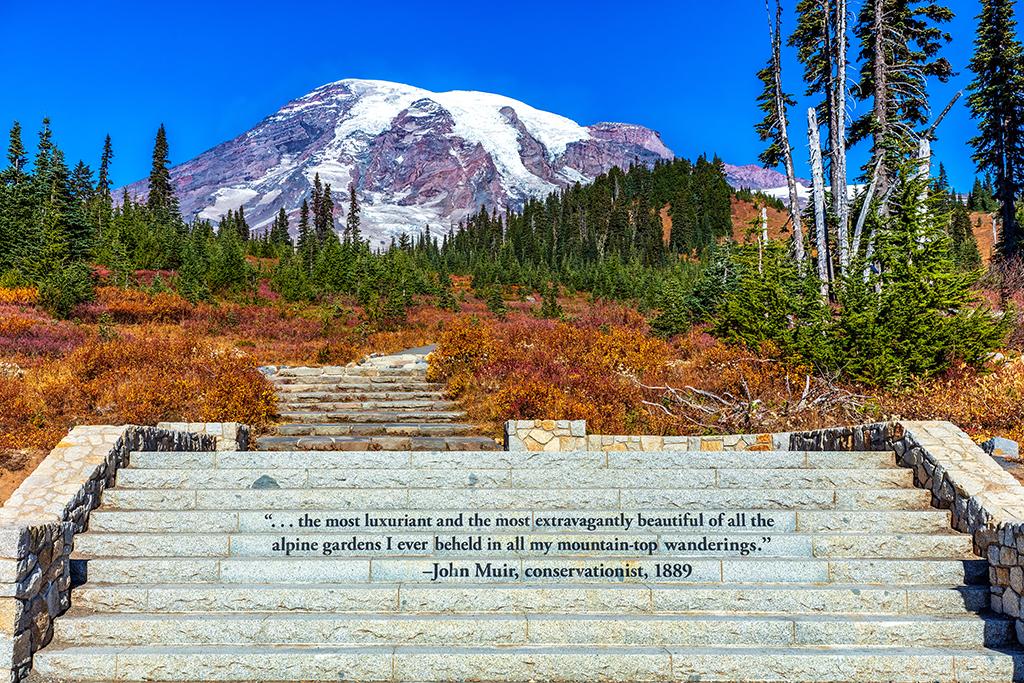
Paradise At Paradise, Mount Rainier National Park / Rebecca Latson
As Mount Rainier National Park struggles at times with long lines of vehicles trying to get into the park, officials are reaching out to the public for suggestions on how best to resolve the issues.
During a Tuesday evening virtual meeting to discuss transportation plan considerations for the park’s Nisqually entrance, park officials and staff further clarified the reasons for the plan, incorporating an online question-and-answer session after the prepared slideshow. Speakers included Superintendent Chip Jenkins, Deputy Superintendent Tracy Swartout, and several other staff.
While visitation has increased at all Mount Rainier’s entrances, prioritization is given to the Nisqually - Paradise Corridor since it’s the only 12-month access route to Paradise. This heavily-trafficked road features a number of popular destinations along the route: Kautz Creek, Longmire Historic District, National Park Inn, Carter, Comet, Christine and Narada Falls.
Following are some of the questions received and answers given during the online public meeting.
Is it feasible to increase park staffing, at least during the busier times of the year?
There are 100 permanent employees at Mount Rainier National Park, and 200+ seasonal employees. In addition to paid permanent and seasonal staff, the park also utilizes volunteers (“Meadow Rovers”) in the park to help the public understand how to recreate responsibly. Park officials welcome ideas by the public on how they might best deploy staffing and how else to share information with the public.
Would expanding access, like reopening areas such as the Carbon River entrance and Westside Road to vehicles, help meet increasing levels of visitation by distribution over a broader landscape?
While staff members are working with partners and other organizations outside of the park to pursue tactics to distributing people over a broader landscape, it is currently not economically or financially feasible to restore vehicle access further into the park (this includes the Carbon River entrance). While there is the possibility of looking at taking financial resources from one area and distributing them to another for more vehicle access and larger visitor distributing, park staff would like to receive more public commentary on this issue before pursuing that route.
Where is the funding coming from for this transportation project? What will the budget be to implement proposals?
There are federal appropriations for managing Mount Rainier National Park and for the park’s projects This transportation plan competed and won the funding against similar projects among other national parks. However, while Mount Rainier has funding for projects, much depends upon the project scale as to whether or not the funding they have can be invested into a particular project. It’s a matter of which action (project) takes the higher priority. (Actual budget numbers were not given in the answer.)
A shuttle bus solution?
Regarding a shuttle system, the park is asking the public to describe what their “dream shuttle” would entail. Are people looking to have all vehicles banned and use shuttles as the only transportation into the park? Or would shuttles be used seasonally, during the heaviest visitation months? How often should the shuttles run, and what time should they begin and end daily? Where would hundreds of cars at a time be parked in order for people to take a shuttle? Officials are looking for “variations or permutations” on this particular idea, and want to remind the public that a shuttle bus option includes capital funding (shuttle bus cost) and operational funding (driver pay, gas expense, bus maintenance). Superintendent Jenkins went on to explain that funding of those systems is done in partnership with state and local communities in addition to whatever monies the park already has.
As a side note, I wrote a 2018 article of my interview with Kate Cannon, then superintendent of the Southeast Utah Group that includes Arches and Canyonlands national parks. One of the items discussed with Superintendent Cannon was Arches’ heavy visitation numbers and whether a shuttle system might help ease parking area stress. This idea was discarded due to the high costs to maintain a shuttle system for the 18-mile park road. The route from the Nisqually Entrance to Paradise is about 19 miles.
Park officials agree that the suggestions looked at for this transportation plan will require collaborative work for a sustainable implementation. As such, even more detailed suggestions and comments from the public are welcomed from now through October 5. People wanting to comment to the park about this plan should click on this link.
Other links associated with the transportation plan:
https://parkplanning.nps.gov/projectHome.cfm?projectId=95095
https://storymaps.arcgis.com/stories/3cc27951027345bcb51779d6a7888d42




 Support Essential Coverage of Essential Places
Support Essential Coverage of Essential Places






